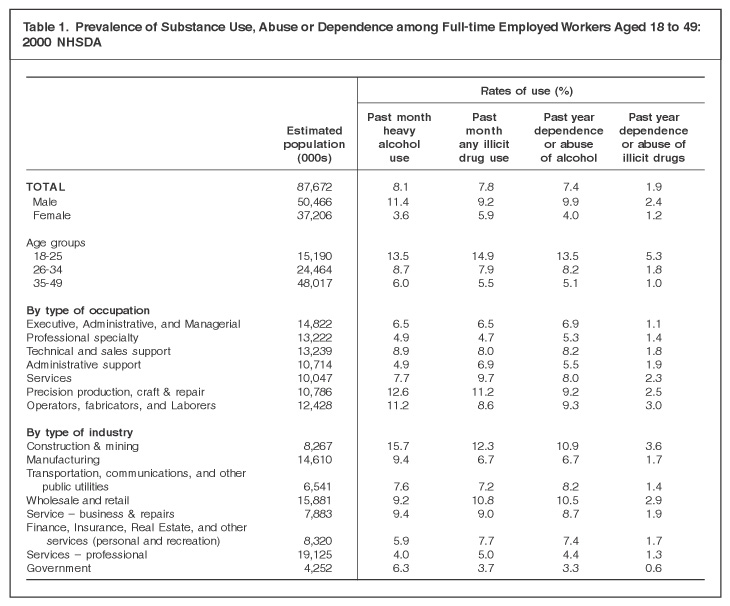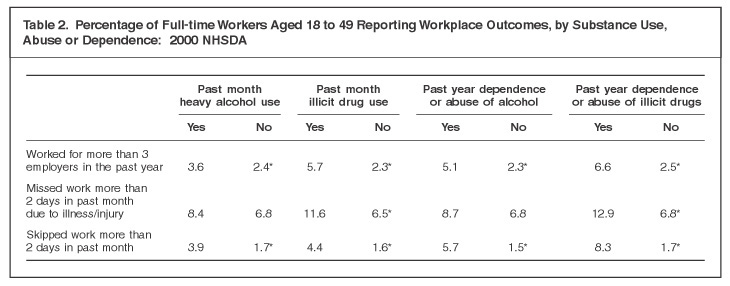


September 6, 2002 |
| Substance Use, Dependence or Abuse among Full-time Workers |
|
In Brief |
|
| In order to promote substance abuse prevention, early intervention, and health care in the workplace, it is important to understand the extent of substance use among US workers. The National Household Survey on Drug Abuse (NHSDA) includes questions about the respondent's work status and type of work. The NHSDA also asks questions that indicate substance dependence or abuse. The classification of dependence or abuse is based on the criteria specified in the Diagnostic and Statistical Manual of Mental Disorders, Fourth Edition (DSM-IV).1 In 2000, the NHSDA reported 107.3 million persons aged 18 to 49 years in the labor force, of whom 81.7 percent (87.7 million persons) worked full-time.2 This report presents data on the prevalence of heavy alcohol use, illicit drug use, dependence or abuse of alcohol, and dependence or abuse of illicit drugs among full-time workers aged 18 through 49.3 |
 |
 |
|
Differences by Gender and Age Among workers, 8.1 percent reported heavy alcohol use in the past month, and 7.8 percent reported illicit drug use in the past month. 7.4 percent were dependent or abusing alcohol in the past year, and 1.9 percent were dependent or abusing illicit drugs in the past year. (Table 1). Rates of dependence and abuse were higher among males than among females. Prevalence of past month heavy drinking among males (11.4 percent) was more than three times the prevalence among females (3.6 percent). The rates of past month substance use were highest among workers aged 18 to 25 years, and declined with older age groups. Past year rate of dependence or abuse of alcohol (13.5 percent) and illicit drug use (5.3 percent) were also highest among the workers in the youngest age group. |
|
Differences by Occupation and Industry The rates of substance use and dependence or abuse were generally higher among workers in precision production, craft and repair jobs, and those who were operators, fabricators, and laborers - occupations that are dominated by males, who have reported higher rates.4 Prevalence of past month heavy alcohol use was 11.2 percent among operators, fabricators, and laborers, and 12.6 percent among workers in precision production, craft, and repair, compared with 4.9 percent among workers in professional specialty. The prevalence of past year dependence or abuse of illicit drugs was 3.0 percent among operators, fabricators, and laborers, compared with 1.1 percent among workers in executive, administrative, and managerial occupations. Workers in the construction and mining industries reported the highest rates while workers in professional services and in government had the lowest rates. This pattern is partially explained by the higher concentration of males in the construction and mining industries.5 Workers in wholesale and retail industries also reported high rates of past month illicit drug use (10.8 percent) and past year dependence or abuse of alcohol (10.5 percent). |
|
Workplace Outcomes Workers who reported past month illicit drug use were more likely than those who did not report such use to say that: they had more than three employers in the past year (5.7 percent vs 2.3 percent), they had missed work for more than two days in the past month due to illness or injury (11.6 percent vs 6.5 percent), and they had skipped work more than two days in the past month (4.4 percent vs 1.6 percent). (Table 2). |
|
End Notes
Table Notes * Indicates difference between users and non-users is statistically significant at the 0.05 level. Source (Tables 1 and 2): SAMHSA 2000 NHSDA. |
| The National Household Survey on Drug Abuse (NHSDA) is an annual survey sponsored by the Substance Abuse and Mental Health Services Administration (SAMHSA). The 2000 data are based on information obtained from nearly 72,000 persons aged 12 or older. The survey collects data by administering questionnaires to a representative sample of the population through face-to-face interviews at their place of residence.
The NHSDA Report is prepared by the Office of Applied Studies (OAS), SAMHSA, and by RTI in Research Triangle Park, North Carolina. Information and data for this issue are based on the following publications and statistics: Substance Abuse and Mental Health Services Administration (2001). Summary of findings from the 2000 National Household Survey on Drug Abuse (National Household Survey on Drug Abuse Series: H-13, DHHS Publication No. SMA 01-3549). Rockville, MD: Author. Also available on-line: http://www.oas.samhsa.gov. Additional tables available upon request. |
| The NHSDA Report is published periodically by the
Office of Applied Studies, Substance Abuse and Mental Health Services Administration (SAMHSA). All material appearing in this report is in the public domain and may be reproduced or copied without permission from
SAMHSA. Additional copies of this fact sheet may be downloaded from
http://www.oas.samhsa.gov/facts.cfm. Citation of the source is appreciated.
Other reports from the Office of Applied Studies are also available on-line on the OAS home page: http://www.oas.samhsa.gov |
|
This page was last updated on December 31, 2008. |
|
SAMHSA, an agency in the Department of Health and Human Services, is the Federal Government's lead agency for improving the quality and availability of substance abuse prevention, addiction treatment, and mental health services in the United States. 
* PDF formatted files require that Adobe Acrobat Reader® program is installed on your computer. Click here to download this FREE software now from Adobe. |